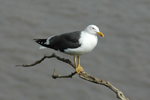Steep Holm visit 12th June 2006
On 12 th June I made a return visit to Steep Holm some 25+ years later. The boat now leaves from Knightstone Harbour. The first time I went was from the long causeway at Birnbeck on a much smaller boat.
We were fortunate enough to be taken around the island for a view of its coastline which was nice. This was not usual and probably due to the people filming onboard the vessel.
The landing was the usual walk along a gang plank on to the small pebbly beach. Some people with smaller strides got wet feet.
Once on the island a walk through the unnamed sycamore wood took us to the plateau where some cut footpaths take you around and over the top of the island.
All in all a very enjoyable day and I won't be leaving it so long before my next visit.
The best find of the day was 2-3 Hummingbird Hawkmoths flying around a rock face above the sycamore wood. Only 2 species of butterfly seen (Red Admiral and Small White) although one observer also saw a Painted Lady. A Garden Carpet in the toilet block. Huge numbers of Brown tail caterpillars seen all over the island.
Birds recorded on the island: Wren, Oystercatcher, Great black-back Gull, Lesser black-back Gull, Herring Gull, Robin, Cormorant, Shelduck, Dunnock, Blackbird, Swift, Magpie, Rock Pipit, Swallow, Song Thrush, Whitethroat.
The Birdlife:
Views from the island:
THE MINERALOGY OF STEEP HOLM by Nick Richards.
Steep Holm is an extension of the limestone of the Mendip Hills, which are folded into an anticline. The southern limb is represented on the island. Along the north side of the island an east-west monoclinal axis upturns the southerly dipping strata. The limestone (Gully Oolite and Birnbeck Limestone) is traversed by a number of small faults (roughly north-south) which displace the strata no more than 20m.
There is also a set of mineralised joints (often occupying the fissures of heamatized neptunean dykes) generally containing calcite and/or white or pink barite. Some galena (lead sulphide) occurs in these although there is no sign of them having been worked (in 18C) as on Flat Holm.
More unusually, solution cavities (of probable Triassic age) are exposed at the north-east corner of the island and contain a lining of mammillated barite which are intersected by the barite bearing joints-evidence that the mineralising events post-date cave formation on the island. Of course these caves bear no relation to modern drainage regimes.
Of most interest is the remarkable contorted barite-fluorite vein (c60cm) of north-south trend which intersects the footpath near the Split Rock Battery. No where in Somerset is fluorite so well developed, where crystals <0.8 cm cover joint surfaces and the vughs in the main body and the wall rock of the vein. This suggests a unique fluorine rich mineralising event denoting a slightly higher temperature of formation than the barite veins alone.
Minerals in the limestone here probably derive from the compaction and heating of strata deep in the Bristol Channel basin which mobilised mineral rich brines and transported them to areas of less pressure i.e. the tops of the Mendip anticlines where precipitation of ores/gangue minerals occurred in suitable host structures such as caves, faults and joints. The mobilising event was probably the extensive crustal rifting associated with the opening of the proto-Atlantic in Jurassic times.
A number of red veins in the cliffs are ferruginous neptunean dykes which are fissures caused by folding or extension of the strata which allowed the injection of material (in this case silts) from later deposits laid down above (which are long removed by erosion). This has provided the locus for oxidised iron-rich solutions to precipitate heamatite. These fissures also provided a suitable environment for the later barite/galena mineralization.

























